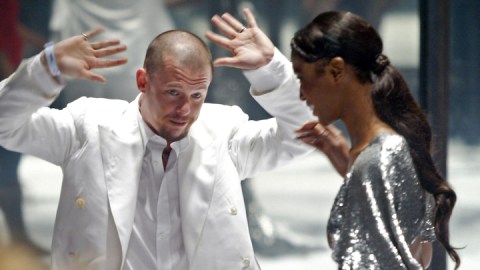A Designer Is Making Leather Goods Out Of Alexander McQueen’s Skin

When it comes to fashion designer Tina Gorjanc’sPure Human line of leather handbags and jackets, the name “Alexander McQueen” may be less of a fashion brand and more a list of ingredients: The handbags and jackets are made from the late designer’s skin.
McQueen, who killed himself in 2010, courted controversy, and he might well get a kick out this idea. His last clothing collection before he died, for example, was asylum-themed, and ended with the sound of a flatlining electrocardiogram as walls of a dark cube slowly descended to reveal a “patient” masked, naked, and (still?) breathing through a tube while covered with butterflies.

“Patient” Michelle Ollie AFP/STRINGER
Gorjanc has been lab-growing McQueen’s skin using DNA from a hair he incorporated into his “Jack the Ripper Stalks His Victims” collection in 1992. Her lab is able to control the skin’s freckles and moles, and can even serve it up sunburned if desired. Gorjanc plans to offer tattoos in the “locations, size, and design” of McQueen’s, she told Quartz.
That the project raises questions is no surprise. That’s Gorjanc’s reason for doing it. After learning about Henrietta Lacks, she began thinking how little there was in the way of legal protection for the ownership of someone’s cells and DNA.

Henrietta Lacks (Wikipedia)
Gorjanc’s concerned that corporations might someday leverage genetic information to develop luxury products. So far, she says, they’re only involved in bioengineering in the pursuit of tissue for product testing without involving animals.
Last May, Gorjanc herself submitted a patent application for “bioengineered genetic material that is grown in the lab using tissue-engineering technology and the process of de-extinction.” De-extinction? It’s the process of getting genetic material from a dead person.
For those of us not concerned with fashion, it’s not hard to imagine all sorts of things that could be done with a person’s genes without their consent, from cloning to transplanting desirable physical attributes from one person — maybe a favorite athlete or singer? — into another. All it would take, theoretically, would be some DNA from a strand of hair, for example. “Abandoned” genetic material like hair clippings don’t legally belong to anyone.
So do you own your genetic material? It’s not clear. For one thing, medical researchers are used to using patients’ tissue samples for testing, though increasingly they’re being required to obtain permission before doing so.
Then there’s the disturbing case of Seattle soft drink salesman John Moore. He was being treated for hairy cell leukemia when his doctor realized his patient’s cells had unique properties. The doctor misled Moore into thinking he had to keep taking samples of the Moore’s blood, sperm, bone marrow and other tissues. He created and patented the “Mo cell line” from Moore’s genetic material, and leased it to a biotech company. When Moore found out he was Patent No. 4,438,032, he sued the doctor. And lost: the court chastised the doctor but ruled Moore couldn’t sue him.

Alexander McQueen (CARLOS ALVAREZ/STRINGER)
As for McQueen’s DNA, he was British, and in the U.K. there’s no ownership of human tissue, so there’s no legal issue here. In any event, people from his circle are aware of Gorjanc’s project and seem to have no issue with it. she says, “People that were really close to him or that worked for his institution said that he might actually like the idea. He was always pushing the boundaries and always trying to break laws in fashion.”





